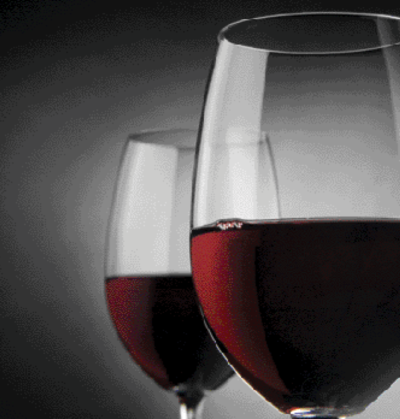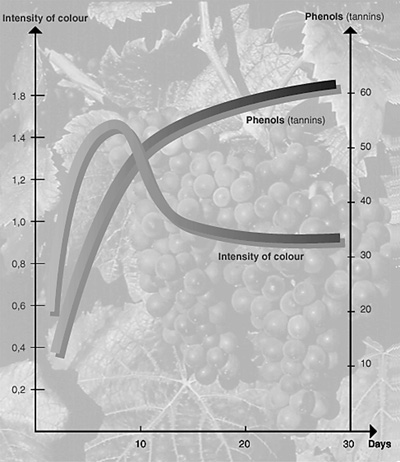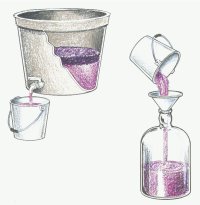 A saturated, dark-ruby colored, full-bodied wine with a velvety texture and round mouthfeel, oodles of blackberry aromas and oak flavor overtones with just a hint of spiciness, all with a persistent, memorable finish. The young, yet soft and elegant tannins make this wine approachable now but it will improve with time and can last another seven to ten years.”
A saturated, dark-ruby colored, full-bodied wine with a velvety texture and round mouthfeel, oodles of blackberry aromas and oak flavor overtones with just a hint of spiciness, all with a persistent, memorable finish. The young, yet soft and elegant tannins make this wine approachable now but it will improve with time and can last another seven to ten years.”
Wow! What a wine!
This was the description from a newspaper columnist of a wine he had tasted at a winemaker-sponsored event. When interviewed by the columnist, the medal-winning winemaker spoke of “gentle phenolic extraction to retain all of the subtle flavors without extracting harsh tannins.” He went on to assert that punching the cap produced more delicate and balanced wines than pumping over because no harsh tannins are extracted.
What are phenolics? What is phenolic extraction? How is it affected by cap management techniques such as punching or pump-over? How does phenolic extraction relate — and translate — to such wine descriptors? What does this all mean?
Wine is a very complex beverage containing countless complex compounds. One of the most important groups of compounds in wines are phenolics, which are derived from phenol, and are responsible for structure and color in red wines. Tannin and anthocyanin are examples of major phenolics found in wine. Tannins are responsible for a wine’s structure and aging potential, and interact with anthocyanins (color pigments found in red grape skins) to provide color stability.
Emile Peynaud, the leading research enologist and teacher of modern winemaking, defines structure as follows: “Diverse flavors from acids, sugars, salts and phenolic substances … that blend into a form, a more or less harmonious volume which makes up structure. [These essential flavors] constitute the bricks and mortar of a wine, its framework, also sometimes described as its bone structure.”
The chemistry of phenolics is complex, but their role in winemaking is well understood, and the application of phenolic extraction in home winemaking enables the crafting of many different styles of wine. This is where the science of winemaking intersects with the art of enology. The same batch of grapes can be crafted into many different styles of wine, all under the winemaker’s control. Let’s examine how.
Phenolics
Phenolics, often referred to as polyphenolics, polyphenols or simply phenols (the chemical name is hydroxy-benzene, which is essentially benzene synthesized by the vine), are compounds including many natural color pigments, such as the anthocyanins of fruit and dark-skinned grapes, most natural vegetable tannins such as occur in grapes, and many flavor compounds (Robinson, 1994).
Grapes are rich in total phenolic content, of which more than half are extracted during winemaking. Phenolic concentration varies greatly between grape varieties as it is determined by such factors as form and structure of grapes, climate and vintage quality (e.g. extent of sun exposure), microclimate (e.g. soil type, drainage efficiency), and harvesting practices. Roughly two-thirds of grape phenolics are found in seeds, up to one-third in the skins, while only a small percentage are found in the juice and pulp. Dark-skinned grapes have a much higher phenolic concentration than white grape varieties and therefore, in general, red wines have a significantly higher phenolic concentration than white wines.
Tannin is the phenolic that impacts wine structure, quality and aging potential the most, and is most often associated with bitterness (as in tonic water) and astringency (as in black tea). For simplicity, tannin can be classified as good or bad. Grape skins, juice and pulp contain good tannins whereas seeds and stems contain bad tannins that impart an overly bitter taste and harsh sensation. For this reason and because of the high concentration of bad tannins in seeds and stems, it is always recommended to destem grape bunches before crushing and to minimize seed handling in order to produce well-balanced wines. Specifically, avoid splitting seeds by choosing a crusher with rollers set sufficiently wide apart, and by avoiding pressing and pumping seeds during these winemaking operations.
Bitterness and astringency from good tannins and acidity must complement each other to balance sweetness in wine. Tannins and acidity work in opposite direction: A low-acidity wine can support a higher tannin concentration and vice versa. A high-acidity wine coupled with a high tannin concentration would be overly astringent and harsh, possibly making the wine undrinkable. Sweetness comes from any residual sugar as well as perceived sweetness from alcohol content.

Tannins not only affect taste and flavors in wine but also interact with anthocyanins (phenolics responsible for color in red wines) to provide color stability and protect wine from premature oxidation effects, resulting in improved aging potential. During aging, tannin concentration decreases because of oxidation and precipitation with protein, resulting in increased suppleness. In general, white wines do not age well because of their considerably lower tannin concentration — up to six-fold less than reds.
Concentration of phenolics can be quantitatively measured, but unfortunately, advanced laboratory procedures, equipment and skills well beyond the scope of home winemakers are required. Home winemakers will have to rely on a visual inspection to assess color and olfactory senses to assess structure. Table 1 lists typical average phenolic concentration in mg/L for some common varietals. Similarly, Table 2 illustrates total gross phenolic concentration for typical table wines from Vitis vinifera grapes. Note: Phenolic concentration is expressed in gallic acid equivalents (GAE).
Factors affecting phenolic extraction
Red winemaking from grapes can be quite a difficult art to master because of the many types of equipment, vinification products, winemaking techniques and environmental factors that must all be considered collectively when producing a desired style. Size of the fermentation vat, destemming practice, fermentation temperature, use of macerating enzymes and cap management are all examples of factors influencing the rate and amount of phenolic extraction and quality of wine.
Tips for phenolic extraction
First, choose a fermentation vat with a fairly large opening relative to its volume. When red wine juice starts fermenting, the grape solids rise to the top of the liquid to form a cap. For optimal phenolic extraction, the surface-to-volume ratio must be optimized. A very tall but slim vat will not optimize the amount of grape solids in contact with the fermenting wine, and will therefore reduce the rate of phenolic extraction. A fermentation vat with a diameter-to-height ratio between 0.5 and 1 is recommended. For example, a 4-foot tall plastic drum with a 30-inch opening would have a ratio of approximately 0.6.
Your crusher should be equipped with two rollers that are set apart sufficiently to allow seeds through without crushing them. Crushing should be performed using a slow and steady pace to minimize extraction of astringent and bitter tannins. Ideally, it should also be equipped with a destemmer to remove stems from grape bunches. Crusher-destemmers for home winemaking usually crush and then destem, so some harsh tannins are extracted. Larger crushers destem the grapes prior to crushing, but these machines are made for commercial wineries.
If your crusher is not equipped with a destemmer, you can remove stems either by hand or with a paddle outfitted with galvanized nails. Some winemakers return some of the stems in low-tannin varieties, such as Pinot Noir and Zinfandel, while others compensate by adding tannin powder. I usually add back up to 25% of mature woody stems when making wine from these varieties. Be careful not to overdo it. Avoid green stems; these tend to have a high pH, causing reduced color intensity and fruitiness. If you prefer enological tannin, add powder at a rate of 10–30 g/hL (approximately 4 to 11 tsp per 100 liters or 25 gallons) by first dissolving it in a small quantity of wine. Add to the batch and stir thoroughly.
At crushing, you may also add macerating enzymes to the must prior to fermentation. Macerating enzymes help break down cell walls of red grapes for a more gentle phenolic extraction, resulting in improved color stability and smoother mouthfeel. Lallemand’s Lallzyme EX or Scott Laboratories’ Scottzyme Color Pro are two examples of recommended macerating enzymes. Follow the manufacturer’s instructions for best results.
Cold soaking (the pre-fermentation practice of soaking crushed grape solids in the juice at low temperature) is used in commercial winemaking to increase color intensity, improve color stability and enhance wine complexity, although the philosophy behind this method is often debated. Some winemakers argue that post-fermentation maceration (the practice of letting grape solids soak in wine for an extended period of time following end of fermentation) is more beneficial than cold soaking because it softens tannins, making the wine more approachable when young.
Higher fermentation temperature increases the rate of phenolic extraction. Winemakers often opt for a quick fermentation, allowing the temperature to rise to 86° F (30° C) to allow maximum color extraction, followed by a post-fermentation maceration to soften tannins. This is in contrast to white winemaking, where a cool fermentation as low as 55° F (13° C) is desired to preserve the more delicate aromas.
In reds, most of the color is extracted during the first few days of fermentation, and then intensity drops off considerably and levels out after the first week. Tannin extraction is also rapid in the first week of fermentation but continues after the first 7–10 days, albeit at a much slower rate, and then tannins soften after a long post-fermentation maceration that can last up to three weeks. An additional benefit of this extended maceration is increased color stability, an important consideration in wines destined for cellar aging.
Alternatively, you could combine the effects of macerating enzymes and temperature to shorten the maceration period (to reduce phenolic extraction) when a deeper color but less astringency is desired.
Once a cap forms during the alcoholic fermentation phase, it must be broken down to keep the grape solids soaked in the wine, to extract phenolics and to prevent spoilage. This process is known as cap management and greatly influences the rate and level of phenolic extraction, and the quality and aging potential of the wine. There are various techniques; the three most important ones are punching, pump-over and delestage.
Punching involves breaking the cap using a plunger tool, and is often argued to be a more gentle extraction technique used in making the best wines. Pump-over uses mechanical means, most often a pump, to circulate wine from the bottom of the fermentation vat to the top to soak the grape solids. Advocates of this technique maintain that aeration and heat dissipation, as a result of pumping, optimize phenolic extraction. Others will argue that the pump’s rough handling of the wine compromises quality by extracting too much bad tannins and imparting too much astringency and bitterness. Delestage is a two-step “rack-and-return” process whereby fermenting red wine juice is separated from the grape solids by racking and then returned to the fermenting vat to re-soak the solids, and then repeated daily. This technique gently extracts phenolics by oxygenating the juice to produce a softer, less astringent wine exhibiting more fruit character. Ultimately, choosing a technique is based on your skills, equipment and desired style of wine.
Aeration, SO2, pH, Oak
Aeration during racking, SO2 additions, pH adjustments and barrel aging are other important factors affecting phenolic extraction and wine quality.
Aeration, during racking operations or from delestage, helps soften tannins as phenolics react with oxygen. To avoid premature aging of the wine, handle the wine gently during racking and minimize the number of racking operations after fermentation.
Increased color stability in red wines is a result of tannins binding with color pigments. SO2, through the addition of sulfite, can negatively affect this and destabilize color, and potentially reduce color intensity. Limit sulfite additions to the recommended free SO2 level — less at crushing to maximize color extraction during maceration. A simple rule is to maintain a free SO2 level equivalent to ten times the wine’s pH. For example, for a wine with a pH of 3.5, the free SO2 level is 35 mg/L. Use the Sulfite Calculator at www.winemakermag.com for help in determining your sulfite additions.
Ideally, the wine’s pH should be between 3.3 and 3.6, keeping in mind that as pH increases, color intensity and stability as well as fruitiness decrease. Higher pH wines will also mature quicker than ones with lower pH, and will be more prone to microbial spoilage.
Undeniably, under the craftsmanship of skilled winemakers, the quality of oak-aged wines can be a few notches above the rest, for those who are partial to this style of wine. Beyond adding oak aromas and flavor, oak wood imparts good tannins that will soften at a slow rate because of the controlled micro-oxidation of wine through the wood and barrel staves. The additional tannins from oak wood will also bind with the color pigments and improve color stability. Large barrels are more beneficial than smaller ones because a greater wine volume undergoes micro-oxidation, resulting in a slower rate of reaction and therefore longer aging potential.
Tannin as a Fining Agent
Tannin also plays a secondary but useful role in winemaking. It can precipitate proteins that cause cloudy wines, a condition known as protein haze, which can be difficult to clear. As such, it is an effective fining agent in both red and white wine applications.
During red wine aging, tannins and proteins bind to precipitate, which clarifies the wine naturally, and also results in a corresponding reduction in tannin concentration. In white wines, which inherently have a low-tannin concentration, tannin is used to avoid over-fining when using protein fining agents such as gelatin or casein that have an affinity in binding to tannins. In low-tannin white wines, add enological tannin powder at a rate of 10–30 g/hL when fining with gelatin. Prepare a tannin solution by dissolving the powder in warm wine and then add it directly to the wine batch, 3–5 days before adding the fining agent. Stir the solution in thoroughly and then rack the wine in 2–3 weeks. Follow the manufacturer’s instructions on preparing protein fining agents.
References
Peynaud, Emile. “The Taste of Wine: The Art and Science of Wine Appreciation” (Macdonald & Co. Publishers, Ltd. 1987).
Robinson, Jancis, ed. “The Oxford Companion to Wine” (Oxford University Press, 1994.)
Zoecklein, Bruce W., Kenneth C. Fugelsang, Barry H. Gump, and Fred S. Nury. “Wine Analysis and Production” (Aspen Publishers, Inc. 1999).






